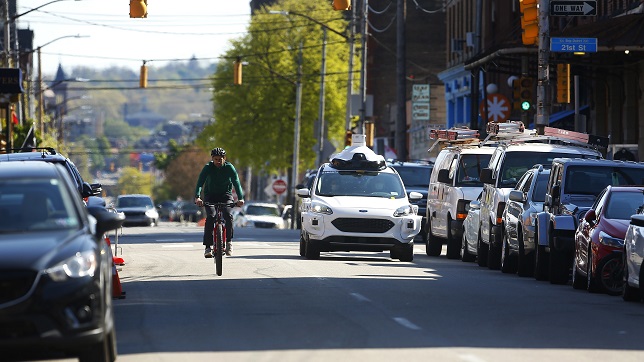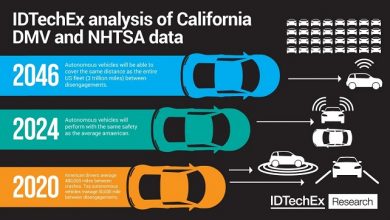Argo AI and The League of American Bicyclists establish autonomous vehicle guidelines for safe driving around cyclists

As part of its commitment to developing self-driving technology that positively impacts communities, Argo AI released the technical guidelines it applies to ensure safe interactions between autonomous vehicles and cyclists and encourages others to do the same. The guidelines, created in collaboration with The League of American Bicyclists, a national advocacy group on a mission to build a Bicycle Friendly America for everyone, are intended as a foundation for further innovation and improvement among companies developing self-driving technology.
“Argo AI is focused on developing self-driving technology that makes cities safer for everyone—in particular cyclists and other vulnerable road users,” said Dr. Peter Rander, president and co-founder of Argo AI. “These technical guidelines deliver on our commitment to developing a self-driving system that is trusted by cyclists and enhances the safety of the communities in which we operate.”
Self-driving technology, defined by SAE International as Levels 4 or 5 automation capability, holds the potential to vastly reduce the number of automotive crashes and resulting injuries and fatalities. According to NHTSA, traffic fatalities of cyclists in the United States rose five percent in 2020 from 2019. Globally, the World Health Organization estimates that 41,000 cyclists die in road traffic-related incidents every year.
“Argo AI and the League of American Bicyclists share a common goal to improve the safety of streets for all road users,” said Ken McLeod, policy director, the League of American Bicyclists. “We appreciate Argo’s proactive approach to researching, developing, and testing for the safety of people outside of vehicles. Roads have gotten significantly less safe for people outside of vehicles in the last decade, and by addressing interactions with bicyclists now, Argo is demonstrating a commitment to the role of automated technology in reversing that deadly trend.”
To understand concerns among cyclists when sharing the road, Argo set out to collaborate and engage with the cycling community. The League of American Bicyclists provided consultation to inform Argo of common cyclist behaviors and typical interactions with vehicles. Together they outlined six technical guidelines for the manner in which a self-driving system should accurately detect cyclists, predict cyclist behavior, and drive in a consistent way to effectively and safely share the road:
#1: Cyclists Should Be a Distinct Object Class
Due to the unique behaviors of cyclists that distinguish them from scooter users or pedestrians, a self-driving system (or “SDS”) should designate cyclists as a core object representation within its perception system in order to detect cyclists accurately. By treating cyclists as a distinct class and labeling a diverse set of bicycle imagery, a self-driving system detects cyclists in a variety of positions and orientations, from a variety of viewpoints, and at a variety of speeds. It should also account for the different shapes and sizes of bikes—like recumbent bikes, bicycles with trailers, electric bikes, and unicycles—as well as different types of riders.
#2: Typical Cyclist Behavior Should Be Expected
An advanced understanding of potential cyclist patterns of movement is necessary to best predict their intentions and prepare the self-driving vehicle’s actions. A cyclist may lane split, yield at stop signs, walk a bicycle, or make quick, deliberate lateral movements to avoid obstacles on the road, like the sudden swinging open of a car door. A SDS should utilize specialized, cyclist-specific motion forecasting models that account for a variety of cyclist behaviors, so when the self-driving vehicle encounters a cyclist, it generates multiple possible trajectories capturing the potential options of a cyclist’s path thus enabling the SDS to better predict and respond to the cyclist’s actions.
#3: Cycling Infrastructure and Local Laws Should Be Mapped
A self-driving system should use high definition 3D maps that incorporate details about cycling infrastructure, like where dedicated bike lanes are located, and include all local and state cycling laws to ensure its self-driving system is compliant. Accounting for bike infrastructure enables the SDS to anticipate cyclists and to maintain a safe distance between the self-driving vehicle and the bike lane. When driving alongside a bike lane, the SDS will consider the higher potential for encountering a cyclist and common cyclist behavior, like merging into traffic to avoid parked cars blocking a bike lane, or treating a red light as a stop sign, which is known as an “Idaho Stop” and is legal in some states.
#4: A SDS Should Drive in a Consistent And Understandable Way
Developers of self-driving technology should strive for the technology to operate in a naturalistic way so that the intentions of autonomous vehicles are clearly understood by other road users. In the presence of nearby cyclists or when passing or driving behind cyclists, a SDS should target conservative and appropriate speeds in accordance with local speed limits, and margins that are equal to or greater than local laws, and only pass a cyclist when it can maintain those margins and speeds for the entire maneuver. In situations where a cyclist encroaches on a self-driving vehicle—for example when lane splitting between cars during stopped traffic—the vehicle should minimize the use of actions which further reduce the margin or risk unsettling the cyclist’s expectations. The SDS should also maintain adequate following distances so that if a cyclist happens to fall, the self-driving vehicle has sufficient opportunity to maneuver or brake. Self-driving vehicles should provide clear indications of intentions, including using turn signals and adjusting vehicle position in lane when they are preparing to pass, merge lanes, or turn.
#5: Prepare for Uncertain Situations and Proactively Slow Down
The reality of the road is that sometimes other road users act unpredictably. A self-driving system should account for uncertainty in cyclists’ intent, direction, and speed—for instance reducing vehicle speed when a cyclist is traveling in the opposite direction of the vehicle in the same lane. When there is uncertainty, the self-driving system should lower the vehicle’s speed and, when possible, increase the margin of distance to create more time and space between the self-driving vehicle and the cyclist and drive in a naturalistic way.
#6: Cyclist Scenarios Should Be Tested Continuously
The key to developing safe and robust autonomy software is thorough testing. Developers of self-driving technology should be committed to continuous virtual and physical testing of its self-driving system with a specific focus on cyclist safety in all phases of development:
- Virtual Testing: the creation and simulation of real-life scenarios in the virtual world to safely test a wide variety of scenarios. A virtual testing program should be made up of three main test methodologies: simulation, resimulation, and playforward to test an exhaustive permutation of autonomous vehicle and cyclist interactions on a daily basis. These scenarios should capture both varying vehicle and cyclist behavior as well as changes in social context, road structure, and visibility.
- Physical Testing: includes testing on closed courses followed by public roads. Testing on a test track validates simulation and ensures the technology behaves in the real world as it did in the virtual world. Scenarios tested should include interactions that are both likely to occur on public roads as well as rare situations, known as “edge cases.” Fleet testing on public roads in multiple cities exposes the technology to a diverse variety of urban environments to first learn about cyclist behaviors and then validate that the self-driving system works as intended.
The development and publication of these guidelines are intended for adoption as industry best practices promoting special consideration of cyclist behavior and interactions. Argo and The League encourage the guidelines to be used by all self-driving technology developers to build trust in self-driving technology as testing and deployments expand and to ensure self-driving systems share the road safely and effectively with cyclists.
“The creation of these guidelines is part of Argo’s dedication to building trust with community members and developing a self-driving system that provides a level of comfort to cyclists, by behaving consistently and safely,” said Dr. Rander. “We encourage other autonomous vehicle developers to adopt them as well to further build trust among vulnerable road users.”
These guidelines build upon the six principles Argo outlined last year for the development of a self-driving system that prioritizes safe interactions with vulnerable road users, through which it set out to contribute to an environment of collaboration, engagement, and education with community advocacy groups.
In addition to input from The League, other members of the cycling community and cycling enthusiasts from the Argo employee resource group provided feedback to ensure the guidelines are broadly representative of various cyclists’ perspectives.
Argo AI currently operates self-driving test vehicles in Miami; Austin, Texas; Washington, D.C.; Pittsburgh; Detroit; and Palo Alto, California. Argo AI also recently expanded on-road testing to Europe including Munich and Hamburg, Germany.




